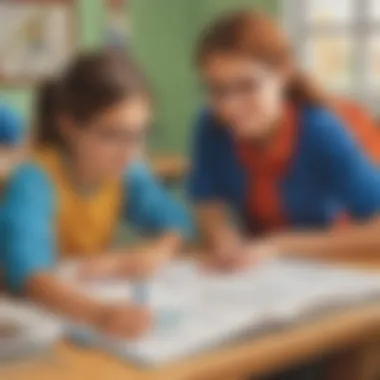Mastering the Art of Teaching 4th Graders: An In-Depth Guide to Engage Young Minds


Creative Activities
Coming up with engaging and educational activities for 4th graders can be both challenging and rewarding. By incorporating creative activities into the curriculum, educators can spark curiosity and inspire a love for learning in their young students. From simple craft ideas to intricate projects, there are numerous ways to stimulate creativity in the classroom. Providing step-by-step guides for each activity ensures that students can easily follow along and participate actively in the learning process. These activities not only enhance artistic skills but also promote critical thinking and problem-solving abilities. Encouraging students to engage in hands-on projects fosters a deeper understanding of concepts and enhances their overall educational experience.
Fun Quizzes
Quizzes serve as effective tools for reinforcing knowledge and assessing comprehension in 4th-grade students. By introducing quiz topics that align with the curriculum, educators can evaluate students' understanding of various subjects while keeping them engaged and motivated. Incorporating a variety of question types, such as multiple choice, true or false, and short answer, ensures that students are exposed to diverse learning formats. These quizzes not only test students' knowledge but also sharpen their analytical and reasoning capabilities. Through regular quiz sessions, students can solidify their grasp of key concepts and develop a deeper appreciation for learning.
Fact-Based Articles
Integrating fact-based articles into 4th-grade education can expand students' knowledge and ignite their curiosity about the world around them. By covering a wide range of topics, from history and science to literature and current events, these articles provide valuable insights and encourage critical thinking skills. Presenting information in an engaging and easy-to-understand manner captivates students' attention and deepens their understanding of complex subjects. Additionally, providing links to additional resources allows students to explore topics further and cultivate a thirst for knowledge outside the classroom. Fact-based articles not only enrich the learning experience but also empower students to become independent, lifelong learners.
Understanding the 4th Grade Mindset
In comprehending the 4th Grade Mindset, one delves into the intricate realm of a child's cognitive and emotional development. This crucial element forms the foundation of effective teaching strategies for nurturing young minds. By grasping the nuances of a 4th grader's mindset, educators can tailor their approaches to better engage students and create a conducive learning environment. Understanding the 4th Grade Mindset entails recognizing the transitional phase these learners are in, where cognitive abilities and emotional intelligence intersect to shape their educational journey.
Cognitive Development
-#### Impact on Learning
Cognitive Development plays a pivotal role in shaping a 4th grader's approach to learning. Understanding its Impact on Learning is essential in tailoring education to suit individual needs and learning styles. This aspect delves into how cognitive growth impacts students' assimilation of knowledge, problem-solving skills, and critical thinking abilities, setting the stage for academic success. Recognizing the impact of cognitive development on learning outcomes empowers educators to adapt their teaching methods to maximize student engagement and comprehension. The unique characteristic of this impact lies in its ability to lay a strong foundation for lifelong learning skills.
-#### Strategies for Cognitive Growth
Strategies for Cognitive Growth are key in honing a 4th grader's intellectual capacities. Implementing effective strategies fosters curiosity, innovation, and a thirst for knowledge in young learners. These strategies encompass diverse approaches such as experiential learning, inquiry-based activities, and targeted interventions to enhance cognitive abilities. By incorporating tailored strategies, educators can address individual learning needs, promote learning retention, and cultivate a growth mindset among students. The distinct feature of these strategies lies in their adaptability to various learning styles and their potential to instill a love for learning in 4th graders.


Emotional Intelligence
-#### Importance of Emotional Support
Emotional Intelligence underscores the significance of emotional support in a 4th grader's educational journey. Acknowledging the Importance of Emotional Support emphasizes nurturing a child's emotional well-being alongside academic growth. Providing a safe and supportive emotional environment enables students to thrive academically and emotionally, paving the way for holistic development. The key characteristic of emotional support lies in its ability to cultivate resilience, empathy, and self-awareness in young learners, fostering a positive classroom atmosphere.
-#### Building Resilience
Building Resilience equips 4th graders with the tools to navigate challenges and setbacks effectively. This aspect focuses on instilling perseverance, adaptability, and problem-solving skills in students. By developing resilience, educators empower children to overcome obstacles, learn from failures, and emerge stronger from adversity. The unique feature of resilience lies in its capacity to build confidence, grit, and emotional regulation in students, preparing them for future academic and personal triumphs.
Effective Teaching Strategies
Effective Teaching Strategies are pivotal in shaping the educational landscape for 4th graders, ensuring a dynamic and enriching learning experience. By meticulously tailoring instructional methods to suit the cognitive and emotional needs of young learners, educators pave the way for comprehensive student engagement and knowledge retention. Strategies like differentiated instruction, interactive teaching approaches, and formative assessment techniques play a crucial role in fostering a stimulating academic environment for 4th-grade students. By integrating various teaching methodologies, teachers can cater to the diverse learning styles present in their classrooms, promoting equitable opportunities for all learners.
Engaging Activities
Hands-on Experiments
Diving into the realm of Hands-on Experiments, we uncover a goldmine of experiential learning opportunities for 4th graders. This interactive approach not only captivates students' attention but also cultivates a deeper understanding of scientific concepts through direct experience and tactile exploration. The inherent hands-on nature of experiments allows young learners to actively participate in the learning process, promoting curiosity and critical thinking skills. While Hands-on Experiments require meticulous planning and supervision, the benefits they offer in terms of student engagement and knowledge retention make them an indispensable tool in the educator's arsenal.
Interactive Group Projects
Exploring the realm of Interactive Group Projects unveils a collaborative learning landscape for 4th-grade students. These projects not only foster teamwork and communication skills but also encourage peer-to-peer knowledge exchange and shared problem-solving. By working together on tasks and assignments, students learn how to navigate group dynamics, negotiate differing opinions, and collectively strive towards a common goal. Despite the challenges of managing group activities, Interactive Group Projects stand out as a preferred choice for educators looking to cultivate a sense of community and collaboration within their classrooms.
Incorporating Technology


Use of Educational Apps
Delving into the realm of Educational Apps, we discover a treasure trove of interactive learning opportunities for 4th graders. These apps are designed to engage young learners through gamified education, interactive quizzes, and multimedia content that cater to diverse learning styles. The key characteristic of Educational Apps lies in their ability to adapt to individual student progress, offering personalized learning experiences that enhance retention and mastery of academic concepts. While the use of Educational Apps requires careful selection and monitoring, their ability to make learning fun and accessible positions them as a valuable asset in modern-day classrooms.
Interactive Whiteboard Tools
Exploring the domain of Interactive Whiteboard Tools reveals a dynamic platform for visual and interactive learning experiences in 4th-grade classrooms. These tools enable educators to present content in a multimedia format, facilitating student engagement and comprehension through interactive exercises, visualizations, and real-time feedback. The key characteristic of Interactive Whiteboard Tools is their versatility in accommodating various teaching styles and content formats, making them a versatile and impactful resource for educators navigating the digital learning landscape. Despite the initial learning curve associated with these tools, their potential to enhance student participation and knowledge retention marks them as a valuable investment in 4th-grade education.
Fostering Creativity and Critical Thinking
Fostering creativity and critical thinking in 4th graders is paramount in developing well-rounded individuals poised for success in an ever-evolving world. Encouraging children to think outside the box and approach problems from multiple perspectives nurtures innovation and ingenuity, crucial skills for the future workforce. By integrating creative activities and thought-provoking exercises into the curriculum, educators lay the foundation for lifelong learning and adaptability. In this section, we delve into the significance of fostering creativity and critical thinking, exploring the myriad benefits it brings to young minds eager to explore and grow.
Encouraging Imagination
Creative Writing Prompts
Creative writing prompts serve as a catalyst for unlocking the boundless imagination of young learners. By presenting open-ended scenarios and thought-provoking questions, creative writing prompts inspire students to articulate their thoughts, feelings, and aspirations through written expression. The beauty of creative writing prompts lies in their ability to ignite a spark of creativity, empowering students to explore various genres, topics, and writing styles. While encouraging imaginative thinking, creative writing prompts also enhance linguistic skills, vocabulary expansion, and storytelling abilities. However, it is essential to strike a balance between structure and freedom to ensure students are both challenged and nurtured in their creative endeavors.
Artistic Expression
Artistic expression offers 4th graders a visual and tactile medium to communicate their emotions, ideas, and experiences. Through drawing, painting, sculpting, or any other creative outlet, students hone their fine motor skills, visual perception, and emotional intelligence. The tactile nature of artistic expression engages different areas of the brain, fostering holistic development and self-expression. Moreover, art provides a safe space for children to experiment, make mistakes, and learn from them without fear of judgment. While promoting creativity and emotional well-being, artistic expression also fosters a sense of accomplishment and pride in one's unique creations. However, it is crucial to provide a supportive environment free of pressure or unrealistic expectations to nurture authentic self-expression and artistic exploration.
Developing Problem-Solving Skills
Challenges and Puzzles


Challenges and puzzles are instrumental in honing 4th graders' problem-solving skills by presenting them with complex tasks that require critical thinking and perseverance to overcome. Engaging with challenges and puzzles not only sharpens analytical abilities but also cultivates resilience, adaptability, and patience in young learners. The iterative process of trial and error inherent in solving puzzles teaches students the value of persistence and creative problem-solving. However, it is essential to offer a range of challenges suitable for varying skill levels to ensure all students are appropriately challenged and supported in their cognitive growth.
Real-World Scenarios
Real-world scenarios simulate practical situations that 4th graders may encounter outside the classroom, requiring them to apply acquired knowledge and problem-solving strategies to real-life challenges. By bridging the gap between theoretical learning and practical application, real-world scenarios deepen students' understanding of concepts and foster critical thinking skills. Encountering authentic dilemmas and decision-making opportunities empowers students to think independently, draw connections between different subjects, and develop strategic thinking skills. However, it is crucial to carefully scaffold real-world scenarios to match students' cognitive abilities and provide meaningful opportunities for reflection and experiential learning.
Building a Supportive Learning Environment
Understanding the significance of fostering a supportive learning environment in the realm of educating 4th graders is vital. A nurturing environment can significantly impact a student's overall development, promoting a sense of safety and belonging conducive to learning. By embracing diversity within the classroom, educators can cultivate respect and understanding among students from varying cultural backgrounds. This inclusivity can enhance the overall learning experience and provide children with a well-rounded education. Furthermore, encouraging collaboration within the classroom fosters crucial social skills and teamwork abilities, preparing students for real-world interactions and challenges that lie ahead.
Embracing Diversity
Within the scope of embracing diversity, cultural awareness plays a pivotal role. Cultural awareness entails recognizing, respecting, and appreciating the differences in cultures present within the classroom. By integrating cultural awareness into teaching practices, educators can create a rich and inclusive learning environment that celebrates diversity. This approach not only broadens students' perspectives but also instills empathy and cultural sensitivity, essential qualities in today's globalized world. However, it's important to consider that promoting cultural awareness should be approached with nuance, ensuring genuine inclusivity rather than token gestures.
Inclusive Teaching Practices
Inclusive teaching practices are paramount in creating an equitable and supportive learning environment. These practices aim to cater to the diverse needs of students, ensuring every individual feels valued and respected. By adopting inclusive teaching strategies, educators can address the unique learning styles and capabilities of each student, fostering a sense of belonging and empowerment. However, it's crucial to note that implementing inclusive practices requires ongoing evaluation and adaptation to ensure effectiveness. While the benefits of inclusive teaching practices are abundant, challenges such as resource constraints and institutional support must also be considered.
Encouraging Collaboration
Collaboration is a cornerstone of effective education, and encouraging collaboration among 4th graders can yield numerous benefits. Peer-to-peer learning allows students to exchange knowledge and ideas, fostering a dynamic learning atmosphere that nurtures creativity and critical thinking. This approach not only enhances academic achievement but also cultivates interpersonal skills and empathy among students. Similarly, team projects offer opportunities for students to work towards a common goal, honing their communication and problem-solving abilities. However, challenges such as group dynamics and varying levels of participation within teams should be addressed to optimize the collaborative learning experience. By incorporating peer-to-peer learning and team projects, educators can instill essential skills that extend beyond the classroom, preparing students for future academic and professional endeavors.







